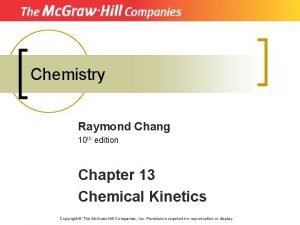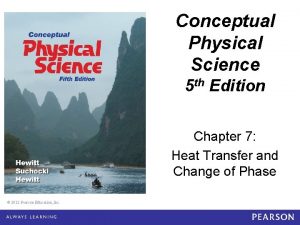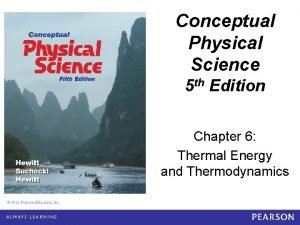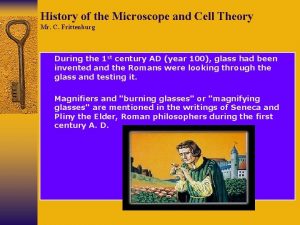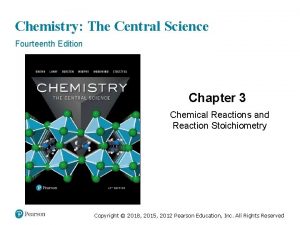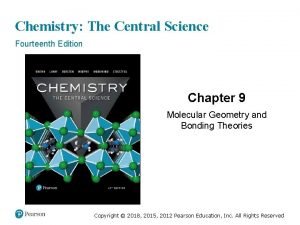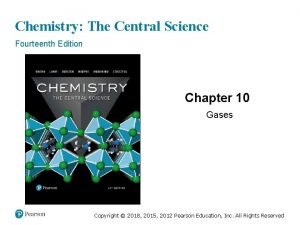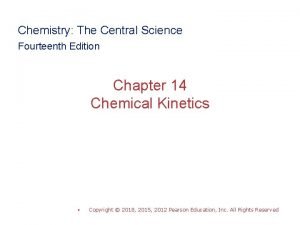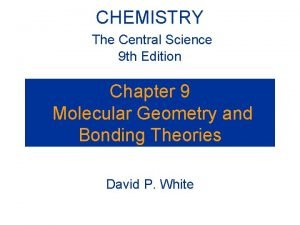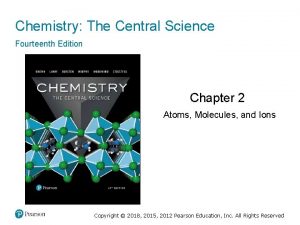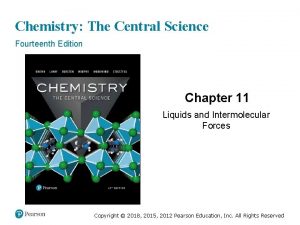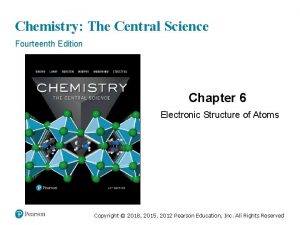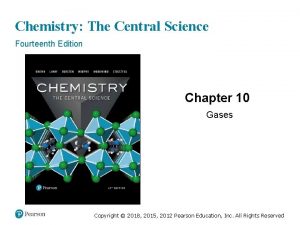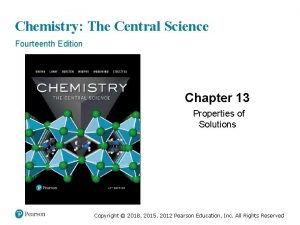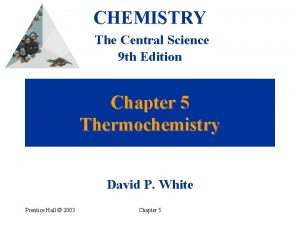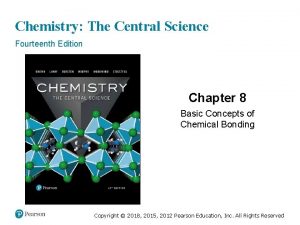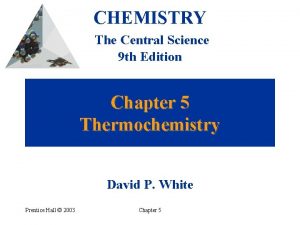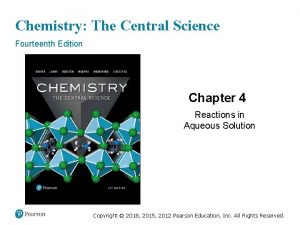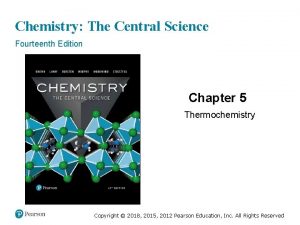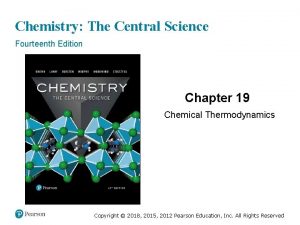CHEMISTRY The Central Science 9 th Edition Chapter
















































- Slides: 48

CHEMISTRY The Central Science 9 th Edition Chapter 7 Periodic Properties of the Elements David P. White Prentice Hall © 2003 Chapter 7

Development of the Periodic Table • In 2002, there were 115 elements known. • The majority of the elements were discovered between 1735 and 1843. • How do we organize 115 different elements in a meaningful way that will allow us to make predictions about undiscovered elements? Prentice Hall © 2003 Chapter 7

Development of the Periodic Table • Arrange elements to reflect the trends in chemical and physical properties. • First attempt (Mendeleev and Meyer) arranged the elements in order of increasing atomic weight. • Certain elements were missing from this scheme. Example: In 1871, Mendeleev noted that As properly belonged underneath P and not Si, which left a missing element underneath Si. He predicted a number of properties for this element. In 1886 Ge was discovered. The properties of Ge match Mendeleev’s predictions well. Prentice Hall © 2003 Chapter 7

Development of the Periodic Table • Modern periodic table: arrange elements in order of increasing atomic number. Effective Nuclear Charge • Effective nuclear charge is the charge experienced by an electron on a many-electron atom. • The effective nuclear charge is not the same as the charge on the nucleus because of the effect of the inner electrons. Prentice Hall © 2003 Chapter 7

Effective Nuclear Charge • Electrons are attracted to the nucleus, but repelled by the electrons that screen it from the nuclear charge. • The nuclear charge experienced by an electron depends on its distance from the nucleus and the number of core electrons. • As the average number of screening electrons (S) increases, the effective nuclear charge (Zeff) decreases. • As the distance from the nucleus increases, S increases and Zeff decreases. Prentice Hall © 2003 Chapter 7

Effective Nuclear Charge • The ns orbitals all have the same shape, but have different sizes and different numbers of nodes. • Consider: He: 1 s 2, Ne: 1 s 2 2 s 22 p 6, and Ar: 1 s 2 2 s 22 p 6 3 s 23 p 6. • The radial electron density is the probability of finding an electron at a given distance. Prentice Hall © 2003 Chapter 7

Prentice Hall © 2003 Chapter 7

Sizes of Atoms and Ions • Consider a simple diatomic molecule. • The distance between the two nuclei is called the bond distance. • If the two atoms which make up the molecule are the same, then half the bond distance is called the covalent radius of the atom. Prentice Hall © 2003 Chapter 7

Sizes of Atoms and Ions • As the principal quantum number increases, the size of the orbital increases. • Consider the s orbitals. • All s orbitals are spherical and increase in size as n increases. • The spherical symmetry of the orbitals can be seen in the contour plots. • Contour plots are connecting points of equal electron density. Prentice Hall © 2003 Chapter 7

Sizes of Atoms and Ions Periodic Trends in Atomic Radii • As a consequence of the ordering in the periodic table, properties of elements vary periodically. • Atomic size varies consistently through the periodic table. • As we move down a group, the atoms become larger. • As we move across a period, atoms become smaller. There are two factors at work: • principal quantum number, n, and • the effective nuclear charge, Zeff. Prentice Hall © 2003 Chapter 7

Prentice Hall © 2003 Chapter 7

Sizes of Atoms and Ions Periodic Trends in Atomic Radii • As the principle quantum number increases (i. e. , we move down a group), the distance of the outermost electron from the nucleus becomes larger. Hence, the atomic radius increases. • As we move across the periodic table, the number of core electrons remains constant. However, the nuclear charge increases. Therefore, there is an increased attraction between the nucleus and the outermost electrons. This attraction causes the atomic radius to decrease. Prentice Hall © 2003 Chapter 7

Sizes of Atoms and Ions • • Trends in the Sizes of Ions Ion size is the distance between ions in an ionic compound. Ion size also depends on nuclear charge, number of electrons, and orbitals that contain the valence electrons. Cations vacate the most spatially extended orbital and are smaller than the parent ion. Anions add electrons to the most spatially extended orbital and are larger than the parent ion. Prentice Hall © 2003 Chapter 7

Prentice Hall © 2003 Chapter 7

Sizes of Atoms and Ions Trends in the Sizes of Ions • For ions of the same charge, ion size increases down a group. • All the members of an isoelectronic series have the same number of electrons. • As nuclear charge increases in an isoelectronic series the ions become smaller: O 2 - > F- > Na+ > Mg 2+ > Al 3+ Prentice Hall © 2003 Chapter 7

Ionization Energy • The first ionization energy, I 1, is the amount of energy required to remove an electron from a gaseous atom: Na(g) Na+(g) + e-. • The second ionization energy, I 2, is the energy required to remove an electron from a gaseous ion: Na+(g) Na 2+(g) + e-. • The larger ionization energy, the more difficult it is to remove the electron. Prentice Hall © 2003 Chapter 7

Ionization Energy Prentice Hall © 2003 Chapter 7

Ionization Energy Variations in Successive Ionization Energies • There is a sharp increase in ionization energy when a core electron is removed. Prentice Hall © 2003 Chapter 7

Ionization Energy Periodic Trends in Ionization Energies • Ionization energy decreases down a group. • This means that the outermost electron is more readily removed as we go down a group. • As the atom gets bigger, it becomes easier to remove an electron from the most spatially extended orbital. • Ionization energy generally increases across a period. • As we move across a period, Zeff increases. Therefore, it becomes more difficult to remove an electron. • Two exceptions: removing the first p electron and removing the fourth p electron. Prentice Hall © 2003 Chapter 7

Ionization Energy Periodic Trends in Ionization Energies • The s electrons are more effective at shielding than p electrons. Therefore, forming the s 2 p 0 becomes more favorable. • When a second electron is placed in a p orbital, the electron-electron repulsion increases. When this electron is removed, the resulting s 2 p 3 is more stable than the starting s 2 p 4 configuration. Therefore, there is a decrease in ionization energy. Prentice Hall © 2003 Chapter 7

Prentice Hall © 2003 Chapter 7

Prentice Hall © 2003 Chapter 7

Ionization Energy Electron Configuration of Ions • Cations: electrons removed from orbital with highest principle quantum number, n, first: Li (1 s 2 2 s 1) Li+ (1 s 2) Fe ([Ar]3 d 6 4 s 2) Fe 3+ ([Ar]3 d 5) • Anions: electrons added to the orbital with highest n: F (1 s 2 2 p 5) F- (1 s 2 2 p 6) Prentice Hall © 2003 Chapter 7

Electron Affinities • Electron affinity is the opposite of ionization energy. • Electron affinity is the energy change when a gaseous atom gains an electron to form a gaseous ion: Cl(g) + e- Cl-(g) • Electron affinity can either be exothermic (as the above example) or endothermic: Ar(g) + e- Ar-(g) Prentice Hall © 2003 Chapter 7

Electron Affinities • Look at electron configurations to determine whether electron affinity is positive or negative. • The extra electron in Ar needs to be placed in the 4 s orbital which is significantly higher in energy than the 3 p orbital. Prentice Hall © 2003 Chapter 7

Electron Affinities Prentice Hall © 2003 Chapter 7

Metals, Nonmetals, and Metalloids Prentice Hall © 2003 Chapter 7

Metals, Nonmetals, and Metalloids • • • Metals Metallic character refers to the properties of metals (shiny or lustrous, malleable and ductile, oxides form basic ionic solids, and tend to form cations in aqueous solution). Metallic character increases down a group. Metallic character decreases across a period. Metals have low ionization energies. Most neutral metals are oxidized rather than reduced. Prentice Hall © 2003 Chapter 7

Metals, Nonmetals, and Metalloids Metals • When metals are oxidized they tend to form characteristics cations. • All group 1 A metals form M+ ions. • All group 2 A metals form M 2+ ions. • Most transition metals have variable charges. Prentice Hall © 2003 Chapter 7

Metals, Nonmetals, and Metalloids Metals Prentice Hall © 2003 Chapter 7

Metals, Nonmetals, and Metalloids Metals • Most metal oxides are basic: Metal oxide + water metal hydroxide Na 2 O(s) + H 2 O(l) 2 Na. OH(aq) Nonmetals • Nonmetals are more diverse in their behavior than metals. • When nonmetals react with metals, nonmetals tend to gain electrons: metal + nonmetal salt 2 Al(s) + 3 Br 2(l) 2 Al. Br 3(s) Prentice Hall © 2003 Chapter 7

Metals, Nonmetals, and Metalloids Nonmetals • Most nonmetal oxides are acidic: nonmetal oxide + water acid P 4 O 10(s) + H 2 O(l) 4 H 3 PO 4(aq) Metalloids • Metalloids have properties that are intermediate between metals and nonmetals. • Example: Si has a metallic luster but it is brittle. • Metalloids have found fame in the semiconductor industry. Prentice Hall © 2003 Chapter 7

Group Trends for the Active Metals • • Group 1 A: The Alkali Metals Alkali metals are all soft. Chemistry dominated by the loss of their single s electron: M M+ + e Reactivity increases as we move down the group. Alkali metals react with water to form MOH and hydrogen gas: 2 M(s) + 2 H 2 O(l) 2 MOH(aq) + H 2(g) Prentice Hall © 2003 Chapter 7

Group Trends for the Active Metals Group 1 A: The Alkali Metals • Alkali metal produce different oxides when reacting with O 2: 4 Li(s) + O 2(g) 2 Li 2 O(s) (oxide) 2 Na(s) + O 2(g) Na 2 O 2(s) (peroxide) K(s) + O 2(g) KO 2(s) (superoxide) • Alkali metals emit characteristic colors when placed in a high temperature flame. • The s electron is excited by the flame and emits energy when it returns to the ground state. Prentice Hall © 2003 Chapter 7

Group Trends for the Active Metals Group 1 A: The Alkali Metals Li line: 2 p 2 s transition Prentice Hall © 2003 Na line (589 nm): 3 p 3 s transition Chapter 7 K line: 4 p 4 s transition

Group Trends for the Active Metals Group 1 A: The Alkali Metals Prentice Hall © 2003 Chapter 7

Group Trends for the Active Metals Group 2 A: The Alkaline Earth Metals Prentice Hall © 2003 Chapter 7

Group Trends for the Active Metals Group 2 A: The Alkaline Earth Metals • Alkaline earth metals are harder and more dense than the alkali metals. • The chemistry is dominated by the loss of two s electrons: M M 2+ + 2 e-. Mg(s) + Cl 2(g) Mg. Cl 2(s) 2 Mg(s) + O 2(g) 2 Mg. O(s) • Be does not react with water. Mg will only react with steam. Ca onwards: Ca(s) + 2 H 2 O(l) Ca(OH)2(aq) + H 2(g) Prentice Hall © 2003 Chapter 7

Group Trends for Selected Nonmetals Hydrogen • Hydrogen is a unique element. • Most often occurs as a colorless diatomic gas, H 2. • It can either gain another electron to form the hydride ion, H-, or lose its electron to become H+: 2 Na(s) + H 2(g) 2 Na. H(s) 2 H 2(g) + O 2(g) 2 H 2 O(g) • H+ is a proton. • The aqueous chemistry of hydrogen is dominated by H+(aq). Prentice Hall © 2003 Chapter 7

Group Trends for Selected Nonmetals Group 6 A: The Oxygen Group Prentice Hall © 2003 Chapter 7

Group Trends for Selected Nonmetals Group 6 A: The Oxygen Group • As we move down the group the metallic character increases (O 2 is a gas, Te is a metalloid, Po is a metal). • There are two important forms of oxygen: O 2 and ozone, O 3. Ozone can be prepared from oxygen: 3 O 2(g) 2 O 3(g) H = +284. 6 k. J. • Ozone is pungent and toxic. Prentice Hall © 2003 Chapter 7

Group Trends for Selected Nonmetals • • • Group 6 A: The Oxygen Group Oxygen (or dioxygen, O 2) is a potent oxidizing agent since the O 2 - ion has a noble gas configuration. There are two oxidation states for oxygen: 2 - (e. g. H 2 O) and 1 - (e. g. H 2 O 2). Sulfur is another important member of this group. Most common form of sulfur is yellow S 8. Sulfur tends to form S 2 - in compounds (sulfides). Prentice Hall © 2003 Chapter 7

Group Trends for Selected Nonmetals Group 7 A: The Halogens Prentice Hall © 2003 Chapter 7

Group Trends for Selected Nonmetals Group 7 A: The Halogens • The chemistry of the halogens is dominated by gaining an electron to form an anion: X 2 + 2 e- 2 X-. • Fluorine is one of the most reactive substances known: 2 F 2(g) + 2 H 2 O(l) 4 HF(aq) + O 2(g) H = -758. 7 k. J. • All halogens consists of diatomic molecules, X 2. Prentice Hall © 2003 Chapter 7

Group Trends for Selected Nonmetals Group 7 A: The Halogens • Chlorine is the most industrially useful halogen. It is produced by the electrolysis of brine (Na. Cl): 2 Na. Cl(aq) + 2 H 2 O(l) 2 Na. OH(aq) + H 2(g) + Cl 2(g). • The reaction between chorine and water produces hypochlorous acid (HOCl) which disinfects pool water: Cl 2(g) + H 2 O(l) HCl(aq) + HOCl(aq). • Hydrogen compounds of the halogens are all strong acids with the exception of HF. Prentice Hall © 2003 Chapter 7

Group Trends for Selected Nonmetals Group 8 A: The Noble Gases Prentice Hall © 2003 Chapter 7

Group Trends for Selected Nonmetals • • Group 8 A: The Noble Gases These are all nonmetals and monatomic. They are notoriously unreactive because they have completely filled s and p sub-shells. In 1962 the first compound of the noble gases was prepared: Xe. F 2, Xe. F 4, and Xe. F 6. To date the only other noble gas compounds known are Kr. F 2 and HAr. F. Prentice Hall © 2003 Chapter 7

End of Chapter 7: Periodic Properties of the Elements Prentice Hall © 2003 Chapter 7
 The central science 14th edition
The central science 14th edition Organic chemistry (3rd) edition chapter 1 problem 16s
Organic chemistry (3rd) edition chapter 1 problem 16s Reaction of grignard reagent with acid chloride
Reaction of grignard reagent with acid chloride Organic chemistry (3rd) edition chapter 2 problem 17s
Organic chemistry (3rd) edition chapter 2 problem 17s Whats your favorite subject
Whats your favorite subject Mis chapter 6
Mis chapter 6 Using mis (10th edition)
Using mis (10th edition) Rearranged most stable carbocation is
Rearranged most stable carbocation is Organic chemistry 2nd edition klein
Organic chemistry 2nd edition klein Introductory chemistry 4th edition
Introductory chemistry 4th edition Introductory chemistry 5th edition nivaldo j. tro
Introductory chemistry 5th edition nivaldo j. tro Introductory chemistry 5th edition nivaldo j. tro
Introductory chemistry 5th edition nivaldo j. tro Organic chemistry david klein 3rd edition
Organic chemistry david klein 3rd edition Zumdahl chemistry, 9th edition notes
Zumdahl chemistry, 9th edition notes Organic chemistry third edition david klein
Organic chemistry third edition david klein General chemistry 11th edition
General chemistry 11th edition Lesson 81 drop in molecular views answer key
Lesson 81 drop in molecular views answer key Chemistry by raymond chang 10th edition
Chemistry by raymond chang 10th edition Fifth edition chemistry a molecular approach
Fifth edition chemistry a molecular approach John wiley & sons, inc.
John wiley & sons, inc. Klein
Klein Functional groups ib chemistry
Functional groups ib chemistry Organic vs inorganic chemistry
Organic vs inorganic chemistry Biological science 6th edition
Biological science 6th edition Rotating snake illusion
Rotating snake illusion When air rapidly expands its temperature normally
When air rapidly expands its temperature normally Bimetallic strip
Bimetallic strip Conceptual physical science 5th edition
Conceptual physical science 5th edition The fundamentals of political science research 2nd edition
The fundamentals of political science research 2nd edition Political science 14th edition
Political science 14th edition Political science 14th edition
Political science 14th edition Science power 9 atlantic edition
Science power 9 atlantic edition Hát kết hợp bộ gõ cơ thể
Hát kết hợp bộ gõ cơ thể Slidetodoc
Slidetodoc Bổ thể
Bổ thể Tỉ lệ cơ thể trẻ em
Tỉ lệ cơ thể trẻ em Voi kéo gỗ như thế nào
Voi kéo gỗ như thế nào Tư thế worm breton
Tư thế worm breton Hát lên người ơi alleluia
Hát lên người ơi alleluia Môn thể thao bắt đầu bằng chữ f
Môn thể thao bắt đầu bằng chữ f Thế nào là hệ số cao nhất
Thế nào là hệ số cao nhất Các châu lục và đại dương trên thế giới
Các châu lục và đại dương trên thế giới Công thức tính độ biến thiên đông lượng
Công thức tính độ biến thiên đông lượng Trời xanh đây là của chúng ta thể thơ
Trời xanh đây là của chúng ta thể thơ Mật thư tọa độ 5x5
Mật thư tọa độ 5x5 101012 bằng
101012 bằng độ dài liên kết
độ dài liên kết Các châu lục và đại dương trên thế giới
Các châu lục và đại dương trên thế giới Thơ thất ngôn tứ tuyệt đường luật
Thơ thất ngôn tứ tuyệt đường luật

















